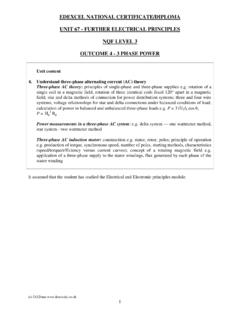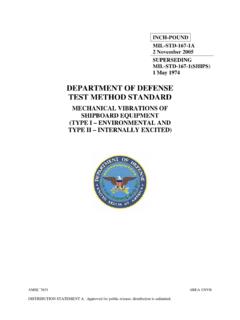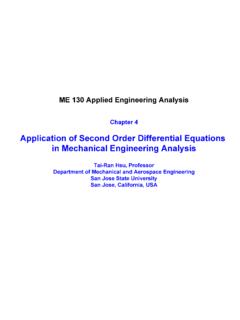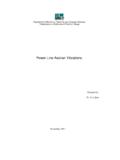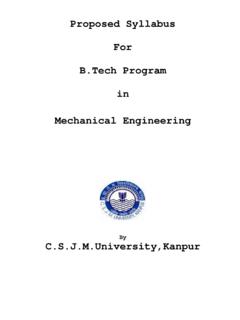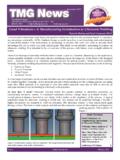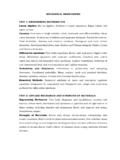Transcription of DYNAMICS TUTORIAL DAMPED VIBRATIONS Exam …
1 SOLID MECHANICS DYNAMICS TUTORIAL DAMPED VIBRATIONS This work covers elements of the syllabus for the Engineering Council Exam D225 DYNAMICS of mechanical Systems, C105 mechanical and Structural Engineering and the Edexcel HNC/D module mechanical Science. On completion of this TUTORIAL you should be able to do the following. Define a free DAMPED oscillation. Explain the purpose of damping. Define damping coefficient. Define damping ratio. Derive formulae that describe DAMPED VIBRATIONS . Determine the natural frequency and periodic time for DAMPED systems. Define amplitude reduction factor. Calculate damping coefficients from observations of amplitude. This TUTORIAL covers the theory of natural VIBRATIONS with damping and continues the studies in the TUTORIAL on free VIBRATIONS .
2 To do the TUTORIAL fully you must be familiar with the following concepts. Simple harmonic motion. Free VIBRATIONS . 2 INTRODUCTION In the TUTORIAL on free VIBRATIONS it was explained that once set vibrating, the system would carry on oscillating for ever because the energy put into the system by the initial disturbance cannot get out of the system. In reality, the oscillation always dies away with time because some form of friction is present. The diagram shows a displacement time graph of a typical DAMPED oscillation. Figure 1 Friction dissipates the energy as heat. Such VIBRATIONS are called free and DAMPED . The type of friction that is easiest to deal with mathematically is that created by a dashpot (also called a damper). Let us now examine two kinds of dashpots.
3 1 DASHPOTS Here we will examine dashpots for linear motion. The diagram shows two types of dashpot, air and oil. AIR-The piston moves inside the cylinder and pumps or sucks air through the orifice. Because of the restriction, pressure is needed to make the air flow through the orifice and this pressure will produce a force opposing the motion. Often the piston is replaced with a simple diaphragm. OIL-The oil is contained in the cylinder and motion of the piston pushes the oil through restrictors in the piston to the other side. Again, pressure is needed to force the fluid through the restrictor and this produces a force opposing motion. It can be shown that for both cases, the force opposing motion (the damping force) is directly proportional to the velocity of the piston.
4 The equation for this force is as follows. dtdx c velocityx constant Fd Figure 2 The constant of proportionality c is called the damping coefficient and has units of N s/m. The value of c depends on the size of the restriction. 3 2. DAMPED LINEAR VIBRATIONS Consider a mass suspended on a spring with the dashpot between the mass and the support. Figure 3 If a force F is applied to the mass as shown, it is opposed by three forces. These are: The inertia force given by 22idtxd M onacceleratix MassF The damping force given by dtdx c velocityx constant Fd The spring force given by Fs = k x The total force is then kxdtdxcdtxdM FFFFF22sdi Because the vibration is free, the applied force must be zero ( when you let go of it). kxdtdxcdtxdM 022 and this is a linear second order differential equation and it is much discussed in most maths books.
5 We make the following changes. First divide each term by k. xdtdxkcdtxdkM 022 4 In the work on undamped VIBRATIONS it was shown that without a dashpot a natural oscillation occurs with angular frequency n = (k/M) rad/s. We may replace (k/M) with n2. xdtdxkcdtxd 1 0222n Next we examine the term c/k. We need to start with a definition. We will be using a term called the critical damping coefficient and it is defined as follows. 4 Mkcc This has the same units as the damping coefficient (N s/m). The ration c/cc is called the damping ratio and this is defined as follows. ccc This may now be developed as follows. nnc 2 kc 2kcMk2kcMk2c4M kccc We can now replace the term c/k in our equation. x dtdx 2dtxd0 by each termmultip ly finally andx dtdx 2 dtxd 1 02nn222nn222n This is now a standard equation and the solution may be found in standard text as x = Aeat + Be-bt A and B are constants of integration and a = { n( 2-1) - 1} b = { n( 2-1) + 1} The resulting graph of displacement x with time t depends upon the damping ratio and hence the value of c.
6 Three important cases should be considered. 5 UNDER DAMPED This occurs when < 1 and c < cc. If we assume that t = 0 and x = C at the moment the mass is released we get a decaying cosinusoidal oscillation as shown. The displacement is described by the following equation. tcostn Cex The graph shows the result if the mass is pulled down 10 units and released. In this case C = -10. Figure 4 The natural undamped angular frequency is n = (k/M) . The DAMPED frequency is = n (1- 2). The DAMPED frequency is f = /2 and the periodic time of the DAMPED angular oscillation is T = 1/f = 2 / AMPLITUDE REDUCTION FACTOR Consider two oscillations, one occurring m cycles after the first. use. toexp ression useful more ap robably is thisand -1m 2 xxlnso lexp onentia theof ridget tolog natural the takenext we and -1m 2 exxhence -1m 2 mT and -1 substitute Now m 2 becomes thisand 2 TPut mT.
7 Term theexamine NowFACTOR REDUCTION AM PLITUDEmT emT)(t -Cet -Cexx is ratio ThemT)(t -Cexsolater seconds mT occcurslater cy cles m'' occursn that oscillatio theof amp litude Thet -Ce xis t at timen oscillatiofirst theof amp litude The2212212n2nnnnnn21n2n1 6 CRITICALLY DAMPED . If the damping is increased, the oscillations die away quicker and eventually a critical point is reached where the mass just returns to the rest position with no overshoot or oscillation. This occurs when = 1 and c = cc. The result is an exponential decay as shown. OVERDAMPED This occurs when > 1 and c > cc. The result is an exponential decay with no oscillations but it will take longer to reach the rest position than with critical damping. Figure 5 7 WORKED EXAMPLE A vibrating system is analysed and it is found that two successive oscillations have amplitudes of 3 mm and mm respectively.
8 Calculate the amplitude reduction factor and the damping ratio. SOLUTION For successive amplitudes m = 1 and and 1 -1 so square -1 2 amp litude 8 WORKED EXAMPLE A mass of 5 kg is suspended on a spring and set oscillating. It is observed that the amplitude reduces to 5% of its initial value after 2 oscillations. It takes seconds to do them. Calculate the following. i. The damping ratio. ii. The natural frequency. iii. The actual frequency. iv. The spring stiffness. v. The critical damping coefficient. vi. The actual damping coefficient. SOLUTION For 2 oscillations m = 2 and x1/x2 = 100/5 = 20 Ns/m x x cc ist coefficien damp ing actual TheNs/m x 5 x 44M kcby given ist coefficien damp ing critical TheN/m 3158 k so 5k8 andsimp lify 5k2 1 4 so Mk2 1fHz -1f fby given isfrequency damp ed TheHz taken timensoscillatio ofnumber theisfrequency natural.
9 05380 1 -1 ( ) -1) (4sidesboth squarenext and -12 2 20ln -1m 2 xxlncc2n2nn2222222222221 9 WORKED EXAMPLE A mass of 5 kg is suspended on a spring of stiffness 4000 N/m. The system is fitted with a damper with a damping ratio of The mass is pulled down 50 mm and released. Calculate the following. i. The DAMPED frequency. ii. The displacement, velocity and acceleration after seconds. SOLUTION You will need to be able to do advanced differentiation in order to follow this solution. 2222t -2n2t -nt -2t -nt -nt x x -22n22nnnnmm/s ( )( )( ) )2)( )(( )( )183.)(0( t50cose t100sine t50cosdtdvaONACCELERATImm/s t50cos e t50sindtdxvVELOCITYmm )( x x tcosCexmm 50- C so mm 50down isnt disp laceme initial Therad/s 1 i)(Answer Hz 1ff Hz frad/s nnnnnnn 10 SELF ASSESSMENT EXERCISE 1.
10 A mass of 50 kg is suspended from a spring of stiffness 10 kN/m. It is set oscillating and it is observed that two successive oscillations have amplitudes of 10 mm and 1 mm. Determine the following.. The damping ratio. ( ) . The damping coefficient. ( N s/m) . The true frequency. ( Hz) 2. A mass of 5 kg is suspended from a spring of stiffness 46 kN/m. A dashpot is fitted between the mass and the support with a damping ratio of Calculate the following.. The undamped frequency. ( Hz) . The DAMPED frequency. ( Hz) . The amplitude reduction factor. ( ) . The critical damping coefficient. (959 N s/m) 3. A mass of 30 kg is supported on a spring of stiffness 60 000 N/m. The system is DAMPED and the damping ratio is The mass is raised 5 mm and then released.









